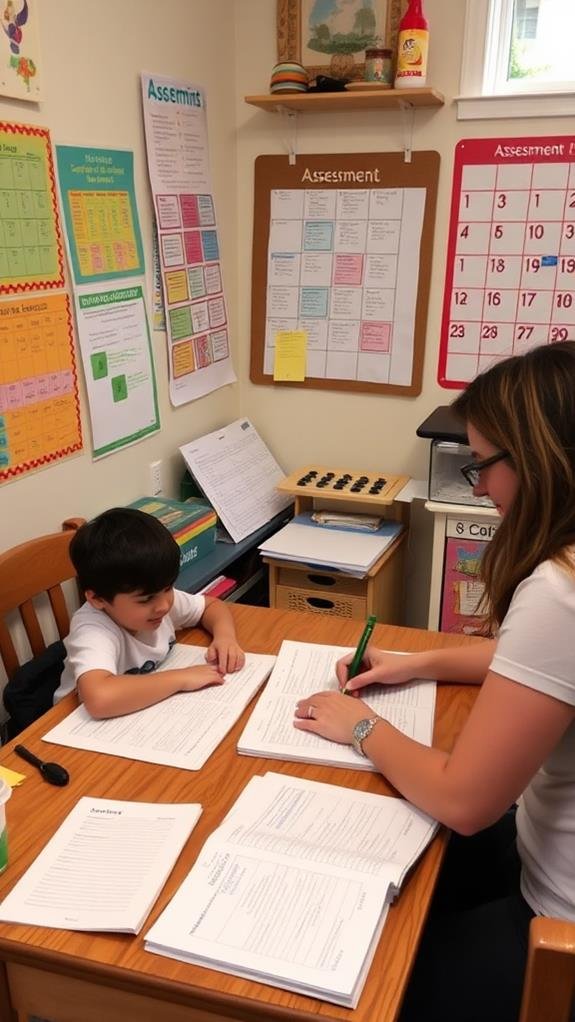Essential Steps to Start Home School
Starting a home school means you need to navigate a series of essential steps to set a strong foundation for your child’s learning. First, you’ll want to clarify your educational goals, then research the local laws that apply. Choosing the right curriculum is vital, but it doesn’t stop there. You’ll also have to create a conducive learning environment and develop a schedule that works for both you and your child. What’s more, how you measure progress and adapt your approach can materially impact the overall experience. So, what’s next on your journey?
Identify Your Educational Goals

Identifying your educational goals is the cornerstone of successful home schooling. When you set clear objectives, you create a roadmap for what you want to achieve.
Think about where you want your child to be academically and socially at the end of the year. Do you want them to master specific subjects, or develop critical thinking skills?
Take time to discuss these aspirations with your child, as their input is valuable. You might also consider balancing academics with life skills, such as budgeting or cooking.
Once you’ve defined these goals, it’ll be easier to choose curriculum materials, activities, and resources that align with your vision. Clear goals keep you motivated and focused every step of the way.
Research Local Laws

Once you’ve established your educational goals, it’s important to understand the legal landscape of home schooling in your area. Each state has different laws regarding home schooling, so you’ll want to research those specific regulations.
Check if you need to notify your local school district, keep attendance records, or submit a curriculum plan. Some states might require standardized testing or evaluations as well. You can usually find this information on your state’s Department of Education website or local homeschooling associations.
Don’t forget to join support groups or forums; they can provide valuable insights and resources based on firsthand experiences. Knowing the laws will help guarantee you’re compliant while giving you peace of mind as you start your home schooling journey.
Choose an Appropriate Curriculum

Choosing an appropriate curriculum for your homeschooling journey provides a solid foundation for your child’s education.
You’ll want to reflect on your child’s learning style, interests, and academic goals. There are various options available, from traditional textbooks to online courses and hands-on methodologies.
Research different subjects and programs to find what best suits your family’s needs. Don’t forget to include diverse materials that promote critical thinking and creativity.
It’s essential to remain flexible; you can always adjust your curriculum as your child grows and their needs evolve. Consult with other homeschooling families or local support groups for recommendations and reviews.
Create a Learning Space

Creating a dedicated learning space can greatly improve your homeschooling experience and boost your child’s focus. You want a quiet area that’s free from distractions, so set up in a room with natural light if possible.
Make sure your workspace has comfortable seating and sturdy furniture for supplies. It’s helpful to have shelves or bins for organizing books and materials, making them easy to access.
Add personal touches, like your child’s favorite artwork, to make the space inviting. Good lighting is key, so consider a desk lamp for those late afternoon study sessions.
Develop a Daily Schedule

A well-structured daily schedule is essential for maintaining focus and productivity in homeschooling. By creating a routine, you’ll help your child understand expectations and manage their time effectively.
Start by setting consistent wake-up and bedtime hours, which can make a big difference in their energy levels. Next, plan specific blocks of time for different subjects, ensuring that you include breaks to keep their minds fresh.
Don’t forget to factor in time for meals and physical activities, as they’re vital for overall well-being. Flexibility is key, so if something isn’t working, feel free to adjust.
Gather Necessary Resources

Once you’ve established a daily schedule, the next step is to gather the necessary resources for your homeschooling journey.
Start by identifying what subjects you’ll teach and what materials you’ll need. Look for textbooks, workbooks, and online resources that align with your curriculum.
Don’t forget about art supplies, science kits, and any other hands-on materials that can make learning more engaging. Local libraries can be goldmines of information, so consider getting a library card too.
Also, connect with other homeschooling families for recommendations on resources and tools they’ve found useful.
Set Up Organizational Systems

Successful homeschooling requires an effective organizational system to keep everything on track. Start by creating a dedicated space for learning—this will help minimize distractions.
Use storage bins or shelves to organize materials by subject, making it easy to find what you need. Schedule your lessons using a calendar or planner, outlining daily activities and breaking tasks into manageable chunks.
Don’t forget to include breaks for both you and your child! Additionally, set up a system for tracking progress, such as a portfolio or checklist, to celebrate achievements and identify areas that need more attention.
Incorporate Various Teaching Methods

To create an engaging learning experience, incorporating various teaching methods is key. Don’t stick to just one style; mixing things up keeps lessons fresh and exciting.
For example, use hands-on activities, like science experiments or art projects, to spark curiosity. Incorporate visual aids, such as videos or diagrams, for those who learn best through sight. Reading aloud helps improve comprehension, while discussions encourage critical thinking.
You might also try online resources like interactive games or quizzes to make learning feel more dynamic. Remember, each child learns differently, so being flexible with your approach allows you to meet their unique needs.
Plan for Socialization Opportunities

Building a strong sense of community is essential for homeschooled children, as it helps foster social skills and emotional growth.
To achieve this, plan regular activities where your child can interact with peers. Look for local homeschooling groups, co-ops, or classes where kids can collaborate and learn together. Don’t forget about extracurriculars, like sports or art clubs, which promote teamwork and creativity.
Also, arrange playdates or community events where your child can make friendships outside the classroom setting.
It’s important to encourage your child to join in, ask questions, and share their ideas. By providing these socialization opportunities, you’re not just enriching their education; you’re also helping them develop lifelong skills they’ll use in the future.
Track Progress and Assessments

After providing socialization opportunities, it’s important to keep an eye on your child’s academic progress and development. You can track progress by setting clear learning goals and regularly evaluating how well your child meets them.
Use a mix of informal assessments, like quizzes or projects, and formal ones, like standardized tests. Don’t forget to maintain a record of their work; it gives you valuable insights into areas where they excel and where they might need extra help.
Additionally, consider using online tools or apps that make tracking progress fun and engaging for kids. Regularly discussing their achievements and challenges encourages a growth mindset and helps your child stay motivated in their learning journey.
Engage With Support Networks

Connecting with support networks can make a significant difference in your homeschooling experience. When you reach out to other homeschooling families or local groups, you gain valuable insights and encouragement.
Joining online forums or social media groups allows you to share resources, ask questions, and exchange ideas. You might even find local co-ops where children can learn together, making the experience more social and interactive.
Don’t forget to attend workshops or meet-ups that focus on homeschooling strategies; they can spark new ideas. Remember, you’re not alone on this journey.
Building relationships with others who share your goal helps you feel more confident and connected, ensuring a smoother and more enjoyable homeschooling experience for you and your children.
Adjust as Needed

Frequently reassessing your homeschooling approach is key to ensuring it meets your family’s needs. As you progress, don’t hesitate to make adjustments. If a subject feels too easy or too challenging, modify your curriculum accordingly.
Keep track of your child’s interests and strengths; this insight will help you tailor lessons to foster their engagement and motivation. Regularly check in with your child to see what’s working and what isn’t. Open conversations create a supportive environment that encourages growth and learning.
Additionally, maintain flexibility in your daily schedule. Sometimes, unexpected events may require you to shift focus or take a break. Adapting to these changes shows that learning can be dynamic and fun, reflecting life outside the classroom.
Celebrate Achievements

Celebrating achievements, big or small, plays an essential role in your homeschooling journey. Acknowledging milestones encourages both you and your child, boosting motivation and reinforcing a positive learning environment.
Take time to celebrate finished projects, mastered skills, or even little victories, like completing a challenging assignment. You can create a simple reward system, such as stickers or treats, to mark these moments.
Consider planning fun activities or outings to celebrate larger accomplishments, like finishing a book or a unit study. Remember, these moments don’t have to be elaborate; a heartfelt note or a “well done” can mean a lot.
Conclusion
Starting your homeschooling journey can be incredibly rewarding. By setting clear goals, understanding local laws, and selecting the right curriculum, you’ll create a solid foundation for your child’s education. Don’t forget to establish a dedicated learning space and a structured schedule to maintain focus. Engage with support networks for encouragement and ideas. Remember, regular assessments help you track progress, and celebrating achievements keeps motivation high. With these steps, you’re well on your way to a successful homeschooling experience!
